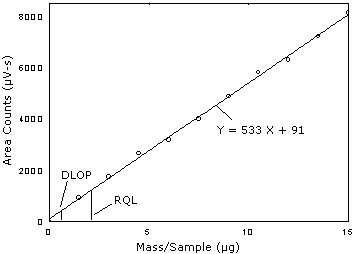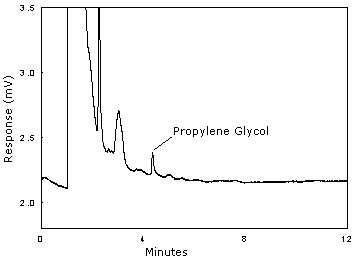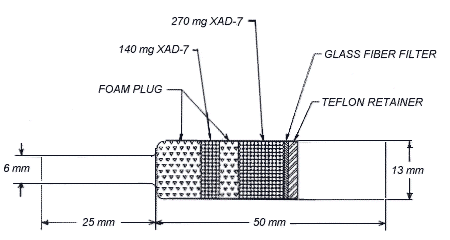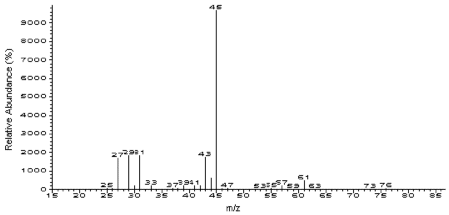Technical Links > Sampling & Analytical Methods > Index
![]()
Technical Links > Sampling &
Analytical Methods > Index

PROPYLENE GLYCOL
Chromatography Team 1. General Discussion
Airborne propylene glycol has been determined by collection on a
37-mm glass fiber filter in a Swinnex cassette followed by a midget
impinger of isopropanol connected in series and analyzed by gas
chromatograph with a flame ionization detector. (Ref. 5.1).
Impingers are difficult for workers to wear and present a
possibility of exposure to the solvent used. NIOSH Method 5523 (Ref.
5.2)
uses the The purpose of this study was to evaluate the collection and analysis of propylene glycol with the OVS-7 tubes at the same level as the ACGIH Ceiling level for ethylene glycol and to test a 60 L air sample for TWA samples. 1.1.2 Toxic effects (This section is for information only and should not be taken as the basis of OSHA policy.) (Ref. 5.3) Taken internally, propylene glycol is harmless, probably because its oxidation yields pyruvic and acetic acids. 1.1.3 Workplace exposure (Ref. 5.4) Propylene glycol is used in organic synthesis, especially polypropylene glycol, polyester resins, cellophane and antifreeze solutions. It is a solvent for fats, oils, waxes, resins, flavoring extracts, perfumes, colors, softdrink syrups, and antioxidants. Propylene glycol is also used as a coolant in refrigeration systems. It is used as an emulsifier, food additive, anticaking agent, solvent, wetting agent, humectant, preservative (retards molds and fungi), and in cleansing creams, suntan lotions, pharmaceuticals, plasticizers, hydraulic fluids, brake fluids, bactericide, textile conditioners and deicing fluids for airport runways. 1.1.4 Physical properties and other descriptive information (Ref. 5.4 unless otherwise indicated).
The analyte air concentrations throughout this method are based on the recommended sampling and analytical parameters. Air concentrations listed in ppm are referenced to 25°C and 101.3 kPa (760 mmHg).
The detection limit of the overall procedure is 2.48 µg per sample (0.016 ppm or 0.041 mg/m3). This is the amount of analyte spiked on the sampler that will give a response that is significantly different from the background response of a sampler blank. The DLOP is defined as the concentration of analyte that gives a response (YDLOP) that is significantly different (three standard deviations (SDBR)) from the background response (YBR).
The direct measurement of YBR and SDBR in chromatographic methods is typically inconvenient, and difficult because YBR is usually extremely low. Estimates of these parameters can be made with data obtained from the analysis of a series of samples whose responses are in the vicinity of the background response. The regression curve obtained for a plot of instrument response versus concentration of analyte will usually be linear. Assuming SDBR and the precision of data about the curve are similar, the standard error of estimate (SEE) for the regression curve can be substituted for SDBR in the above equation. The following calculations derive a formula for the DLOP:
At point YDLOP on the regression curve
therefore
 Substituting 3(SEE) + YBR for YDLOP gives
 The DLOP is measured as mass per sample and expressed as equivalent air concentrations, based on the recommended sampling parameters. Ten samplers were spiked with equal descending increments of analyte, such that the lowest sampler loading was 1.50 µg/sample. This is the amount, when spiked on a sampler, that would produce a peak approximately 10 times the background response for the sample blank. These spiked samplers, and the sample blank were analyzed with the recommended analytical parameters, and the data obtained used to calculate the required parameters (A and SEE) for the calculation of the DLOP. Values of 532.52 and 111.31 were obtained for A and SEE respectively. DLOP was calculated to be 0.63 µg/sample (0.003 ppm or 0.010 mg/m3).
Detection Limit of the Overall Procedure
 Figure 1.2.1 Plot of data to determine the DLOP/RQL. 1.2.2 Reliable quantitation limit (RQL) The reliable quantitation limit is 2.09 µg per sample (0.011 ppm or 0.035 mg/m3). This is the amount of analyte spiked on a sampler that will give a signal that is considered the lower limit for precise quantitative measurements. The RQL is considered the lower limit for precise quantitative measurements. It is determined from the regression line data obtained for the calculation of the DLOP (Section 1.2.1), providing at least 75% of the analyte is recovered. The RQL is defined as the concentration of analyte that gives a response (YRQL) such that
therefore
 RQL = 2.09 µg per sample (0.011 ppm or 0.035 mg/m3) The recovery at the RQL is 100%
 Figure 1.2.3 Chromatogram of the RQL. 2. Sampling Procedure
2.1.2 Samples are collected using OVS-7 tubes, which are
specially made 11-mm i.d. × 13-mm o.d. × 5.0 cm long glass tubes
that taper to 6-mm o.d. × 2.5 cm. Each tube is packed with a 140-mg
back section and a 270-mg front section of
 2.2 Technique
2.2.2 Attach the small end of the sampling tube to the pump with flexible tubing. Position the tube so that sampled air passes through the front section (GFF) of the tube first. 2.2.3 Air being sampled should not pass through any hose or tubing before entering the sampling tube. 2.2.4 Attach the sampler vertically with the open end pointing downward, in the worker's breathing zone, and positioned so it does not impede work performance or safety. 2.2.5 After sampling for the appropriate time, remove the sample and seal the tube with plastic end caps. Wrap each sample end-to-end with a Form OSHA-21 seal. 2.2.6 Submit at least one blank sample with each set of samples. Handle the blank sampler in the same manner as the other samples except draw no air through it. 2.2.7 Record the sample volume (in liters of air) for each sample, along with any potential interferences. 2.2.8 Ship any bulk samples in separate containers from the air samples. 2.2.9 Submit the samples to the laboratory for analysis as soon as possible after sampling. If delay is unavoidable, store the samples in a refrigerator. 2.3 Extraction and desorption efficiency The extraction and desorption efficiencies of propylene glycol were
determined by liquid-spiking the 13-mm glass fiber filters and also an
amount of
Extraction Efficiency of Propylene Glycol From GFF
Desorption Efficiency of Propylene Glycol From
2.4 Retention efficiency The glass fiber filter of six sampling tubes was physically
separated from the
Retention Efficiency of Propylene Glycol
2.5 Sample storage The glass fiber filters of twenty-four sampling tubes were each spiked with 1497.8 µg (99.9 mg/m3 based on a 15 L air sample) of propylene glycol. They were sealed and stored at room temperature. The next day 60 L of humid air (80% RH at 25°C) was drawn through each tube at 1.0 L/min. Half of the tubes were stored in a drawer at ambient temperature and the other half were stored in a refrigerator at 0°C. After 10 days of storage six samples from the tubes stored under refrigeration and six samples from ambient storage were analyzed. The remaining samples were analyzed after 17 days of storage. The average recovery of the ambient and refrigerated storage samples was 97.2%.
Storage Test for Propylene Glycol
2.6 Recommended air volume and sampling rate. Based on the data collected in this evaluation, 60 L air samples should be collected at a sampling rate of 1.0 L/min for TWA samples and 15 L at 1.0 L/min for ceiling samples. 2.7 Interferences (sampling)
2.7.2 Suspected interferences should be reported to the laboratory with submitted samples. 2.8 Safety precautions (sampling)
2.8.2 Follow all safety practices of the Chemical Hygiene Plan that apply to the work area being sampled. 2.8.3 Wear eye protection at all times while in the work areas. 3. Analytical Procedure
3.1.2 A GC column capable of separating the analyte from any interferences. The column used in this study was a 30 meter Rtx-35 fused silica capillary column with a 3.0 µm film thickness and 0.53 mm i.d. 3.1.3 An electronic integrator or some suitable method of measuring peak areas. A Hewlett Packard model 3396A and the Waters Millennium Data System was used in this study. 3.1.4 Four milliliter vials with TeflonTM-lined caps. 3.1.5 A 10-µL syringe or other convenient size for sample injection. 3.1.6 Pipets for dispensing the desorbing solution. A 2-mL Labindustries dispenser was used in this study. 3.1.7 Volumetric flasks - 10-mL and other convenient sizes for preparing standards. 3.1.8 A balance for weighing propylene glycol in standard preparation. A Ohaus Galaxy 160D was used in this evaluation. 3.2 Reagents
3.2.2 Propylene glycol (CAS 57-55-6), Reagent grade. Eastman, Lot A7A, was used in this evaluation. 3.2.3 Methanol (CAS 67-56-1), Certified Spectanalyzed grade. Fisher Chemical, Lot 970338, was used in this evaluation. 3.3 Standard preparation
3.3.2 Dilutions of these stock standards were prepared to bracket the samples. The range of the standards used in this study was from 74.9 to 1497.8 µg/mL. 3.4 Sample preparation
3.4.2 Each section is desorbed with 2 mL of methanol. 3.4.3 The vials are sealed immediately and allowed to extract/desorb for one hour on a mechanical rotator or the vials are shaken vigorously by hand several times during the extraction/desorption time. 3.4.4 Transfer some of the solution from each of the 4-mL vials to smaller glass vials suitable for an autosampler if necessary. 3.5 Analysis
3.5.2 Peak areas are measured by an integrator or other suitable means. 3.6 Interferences (analytical)
3.6.2 When necessary, the identity or purity of an analyte peak may be confirmed by a GC-mass spectrometer or by another analytical procedure.
 Figure 3.6.2 Mass spectra of propylene glycol. 3.7 Calculations
3.7.2 The values for the samples are obtained from the calibration curve. 3.7.3 To calculate the concentration of analyte in the air sample the following formulas are used:
* All units must cancel. 3.7.4 The above equations can be consolidated to the following formula.
3.7.5 To calculate the mg/m3 of analyte in the sample based on a 60 liter air volume:
where:
3.7.6 This calculation is done for each section of the sampling tube and the results added together after a blank correction is performed, if necessary. 3.8 Safety precautions
3.8.2 Avoid skin contact and inhalation of all chemicals. 3.8.3 Wear safety glasses, gloves and a lab coat at all times while in the laboratory areas. 4. Recommendations for Further Study Collection studies should be performed with controlled test atmospheres. This method does not differentiate between particulate and vapor so more work could be done to find a sampling device that would do that. 5. References
5.2 National Institute for Occupational Safety and Health: Method No. 5523, Glycols, in NIOSH Manual of Analytical Methods. 4th ed., Vol. 1, Cincinnati, OH: National Institute for Occupational Safety and Health, 1996. 5.3 The Merck Index, 12th ed.; Budavari, S., Ed.; Merck & Co., Whitehouse Station, NJ, 1996, p 1349. 5.4 Hawley's Condensed Chemical Dictionary, 12th ed.; Revised by Lewis, R. J.; Van Nostrand Reinhold: New York, 1993; pp 970-971. 5.5 Sweet, D., "Registry of Toxic Effects of Chemical Substances", 1985-86 ed., U.S. Department of Health and Human Services, Public Health Service, Center for Disease Control, NIOSH, 1987, Vol. 4, Index Number TY2000000, p.3768.
| |||||||||||||||||||||||||||||||||||||||||||||||||||||||||||||||||||||||||||||||||||||||||||||||||||||||||||||||||||||||||||||||||||||||||||||||||||||||||||||||||||||||||||||||||||||||||||||||||||||||||||||||||||||||||||||||||||||||||||||||||||||||||||||||||||||||||||||||||||||